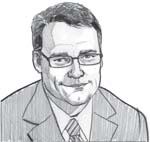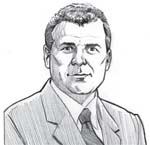Brian Stacy
Is there something that’s being overlooked because everybody has put so much focus toward solid-state lighting right now? Myer: R&D comes from three places: government, academic research, and industry. Manufacturers are going to chase where they think there is either money to be had or money on the table. The Department of Energy does support many different technologies through R&D and non-R&D efforts, not just LED. We have many lighting programs which support non-solid-state lighting entirely. We are also seeing R&D happen as a result of federal and state appliance standards that force lighting technologies to get better.
Stacy: One other part of the equation is the whole venture capital [VC] funding mechanism, and I think the vast majority of the money that’s going into R&D—the VC money that’s going into lighting—is into LEDs, whether it be the standard LEDs, OLEDs, or controls.
Why is it that solid-state lighting is under a kind of scrutiny that’s very different from what other sources have had in the past? Steen: To get into LEDs is as simple as somebody having a reflow machine … to put some prepackaged LED downlight to a board. In the past, you had to spend $10 million on an Circle no. 63 or http://archlighting.com/productinfo HID line; there were very few people that would be jumping into that game. Plus, there is the entire promise of the huge energy savings. Without the scrutiny and the potential glut of bad product, that could be a recipe to not achieve the energy savings. Would you agree with that, Michael?
Myer: The cost is different and there are a lot of people who are coming from another industry. They can make some great semiconductors but not lighting products. Scrutiny is warranted, even if it’s more. Barbara used a great word earlier—panacea. In the last 20 years, there have been two things that everyone has been jazzed about—fiber optics and LEDs. Fiber optics didn’t pan out, and this one [LEDs] seems to be the one with a real foothold. People are saying, “Let’s make sure it’s not another flash in the pan.”
Stacy: With other lamp technologies, it’s primarily been one of the majors that were tweaking or coming up with a new source. Now there are so many other players. We have to see how it all plays out.
Lind: My memories of new lamps [are] tied to very targeted applications. They identified a couple of very good areas where the product could be successful, and certainly early LEDs did just that. A lot of the initial LEDs were in the accent side or theatrical side where they weren’t the primary illumination of the space.
LEDs are coming on the heels of the CFL being “the solution for the world.” I don’t think everybody’s expectations of that lamp were ever satisfied. So there is a little bit of a “Wow, this is incredible,” and also a “We did this just a few years ago, are we making the same mistake that everything can be solved?” It’s a very good scrutiny, quite honestly.
| “Two or three years ago, efficacies were sitting around 10 to 20 lumens per watt. Now we are seeing 50, 60, 70 lumens per watt with a theoretical headroom of 220. … It’s better we prepare for the ride.” — Ron Steen |
What do you say to your colleagues who are frustrated right now with LEDs in terms of specifying them? Horton: I don’t know if my colleagues are frustrated. I know that there is more worry—and the liability, they’re sensing it. But I don’t know that people are frustrated about it. I think the design community is very excited about the possibilities. It opens up a whole different world for us and I think that’s really exciting.
Fisher: There may be some frustration when you’re writing specifications, but I think it’s more the frustration when you’ve written your specifications and people are sending back things and not referencing the spec document.
Where do you see solid-state lighting in the next few years? Steen: We’re going to be riding this curve until we reach the theoretical maximum. What I am really hoping for is understanding … the lighting metrics that we really care about with LEDs. Are we going to accept lower light levels because we can do other things optically?
Horton: There are so many possibilities. The “smart thinking” of the fixture is the way that LED should go.
Stacy: I second that. There’s been a relatively quiet [but] major addition to the DMX Control Protocol. It would be great to see some of that feedback logic that exists as part of DMX RDM to work its way onto a wider distribution to deal with things like thermal management or load setting with a more cost-effective approach.
Myer: More feedback and integrated controls are needed.
Steen: It’s about the integration of controls, controls-based systems, and intelligent LEDs.





